

Examples of Song lyrics : Poetry through the Ages. The journey from Ancient Greece.
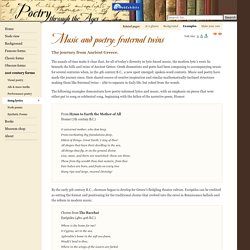
The annals of time make it clear that, for all of today’s diversity in lyric-based music, the modern lyric’s roots lie beneath the hills and ruins of Ancient Greece. Greek dramatists and poets had been composing to accompanying music for several centuries when, in the 4th century B.C., a new sport emerged: spoken-word contests. Music and poetry have made the journey since, their shared source of creative inspiration and similar mathematically-inclined structures making them like fraternal twins – able to separate in daily life, but yoked from the womb. The following examples demonstrate how poetry informed lyrics and music, with an emphasis on pieces that were either put to song or celebrated song, beginning with the father of the narrative poem, Homer: By the early 5th century B.C., choruses began to develop for Greece’s fledgling theater culture.
Essential Humanities. [cite] MLA"Medieval Literature.
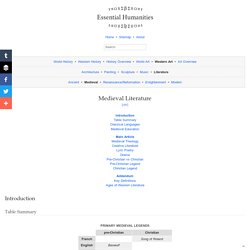
" Essential Humanities. N.p., n.d. Web. 31 Mar. 2016. APAMedieval Literature. (2016). Medieval poetry. Because most of what we have was written down by clerics, much of extant medieval poetry is religious.
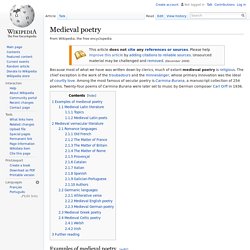
The chief exception is the work of the troubadours and the minnesänger, whose primary innovation was the ideal of courtly love. Among the most famous of secular poetry is Carmina Burana, a manuscript collection of 254 poems. Twenty-four poems of Carmina Burana were later set to music by German composer Carl Orff in 1936. What are the three characteristics of the Middle Ages literature? - Homework Help. The Middle Ages saw the beginnings of a rebirth in literature.
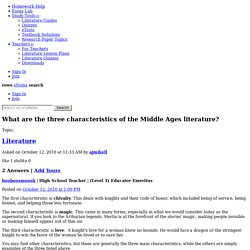
Early medieval books were painstakingly hand-copied and illustrated by monks. Paper was a rarity, with vellum, made from calf's skin, and parchment, made from lamb's skin, were the media of choice for writing. Students learning to write used wooden tablets covered in green or black wax. The greatest number of books during this era were bound with plain wooden boards, or with simple tooled leather for more expensive volumes. Ethnic groups in Europe. The history of bloodletting. With a history spanning at least 3000 years, bloodletting has only recently—in the late 19th century—been discredited as a treatment for most ailments.
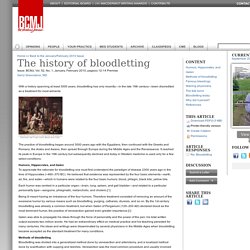
A Brief History of Bloodletting - History in the Headlines. The ancient practice of bloodletting might offer cardiovascular benefits to obese people with metabolic syndrome, a new study published today in the journal BMC Medicine suggests.
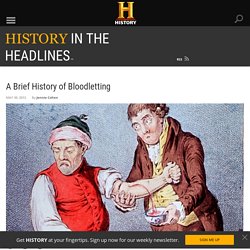
As the medical community contemplates its revival, explore this long-abandoned procedure’s age-old history, from its early roots to its use on figures such as George Washington and Marie-Antoinette. Several thousand years ago, whether you were an Egyptian with migraines or a feverish Greek, chances are your doctor would try one first-line treatment before all others: bloodletting. He or she would open a vein with a lancet or sharpened piece of wood, causing blood to flow out and into a waiting receptacle. Bloodletting. Ancient Greek painting on a vase, showing a physician (iatros) bleeding a patient Bloodletting (or blood-letting) is the withdrawal of blood from a patient to cure or prevent illness and disease.
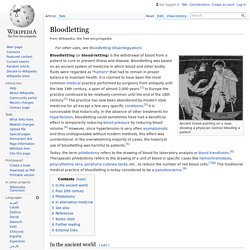
Bloodletting was based on an ancient system of medicine in which blood and other bodily fluids were regarded as "humors" that had to remain in proper balance to maintain health. Crazy Medieval Medical Practices We Still Use. Medieval times were dark and without reason, or at least that’s what we’re taught to think.
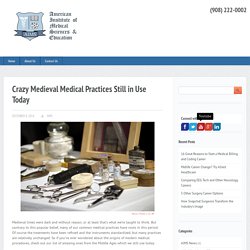
But contrary to this popular belief, many of our common medical practices have roots in this period. Of course the treatments have been refined and the instruments standardized, but many practices are relatively unchanged. So if you’ve ever wondered about the origins of modern medical procedures, check out our list of amazing ones from the Middle Ages which we still use today: #1 Bloodletting A.K.A Phlebotomy We’re all shocked and disgusted when we hear about medieval bloodletting, but this seemingly crazy practice is still used today. . #2 Drilling Into Your Head?
Ever have a headache so bad you’d be willing to have someone drill a hole in your head to make it stop? #3 Saving Sight, or Torture? Royal touch. Origins[edit] A 15th-century manuscript depicting the tradition that Clovis I healed the scrofulous following his coronation.

The kings and queens regnant of England and the kings of France were the only Christian rulers who claimed the divine gift (divinitus)[4] to cure by touching or stroking the diseased.[2] This special aptitude was thought to be evidence of God's high esteem of the two monarchies, though they never agreed upon whose predecessors the ability was first conferred.
In England, Saint Edward the Confessor (r. 1042–1066) was said to be the first monarch to possess the healing power of the royal touch.[2] The French, who normally traced the origins of their monarchs' divine gift back to Philip I (r. 1059–1108) or even Robert II (r. 987–1031), denied that Saint Edward used the royal touch. England[edit] Henry I's successors did not consider the royal touch fundamental, reducing its application. Procedure[edit] Frequency[edit] France[edit] Wars of Religion[edit] See also[edit] 10 Completely Uncanny Superstitions From The Middle Ages. Weird Stuff In the pre-scientific Middle Ages, the world was at the same time both fascinating and frightening.

In the absence of proper knowledge, people had no choice but to fall back on their own imaginations to make sense of the myriad natural phenomena around them. The result was a world where everything seemed magical, a place teeming with angels and demons, fairies and goblins, elves, gnomes, and witches. BritlitwithBeavers - Characteristics of Medieval Literature. Skip to main content Try Wikispaces Classroom now. Brand new from Wikispaces. guest Join | Help | Sign In BritlitwithBeavers Home guest| Join | Help | Sign In Turn off "Getting Started"
Medieval Romance Literature: Definition, Characteristics & Novels. Readers in the Middle Ages didn't have any Harlequin paperbacks, but works of medieval romance literature were just as plentiful and popular. Learn more about this literary genre, its characteristics, and some of its examples in this lesson. Explore our library of over 10,000 lessons Click "next lesson" whenever you finish a lesson and quiz. Got It You now have full access to our lessons and courses. Medieval History Timeline. Medieval History Timeline. Medieval Literature. Facts and interesting information about Medieval Life,specifically, Medieval Literature Medieval Literature - The Dark Ages and the BardsEnglish Medieval literature had, so far as we know, no existence until Christian times of the Dark Ages when Latin was the language of English literature. English Medieval literature was not written. It is was passed by word of mouth from one generation to another by English, Welsh and Irish bards.
Medieval literature. Medieval History, Castles. MedievalPlus.com The Middle Ages is a period in European history which, along with its adjective ‘Medieval’, was first referred to by italian scholars and academics of the late fifteenth century.